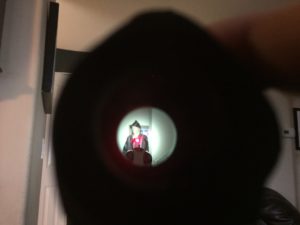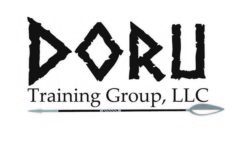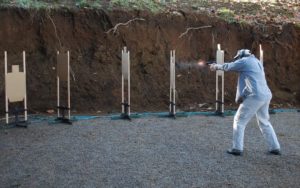
(Image: “Force on Target” training-view through red dot optic at clothed 3D target in home.)
Partial List of Training Methods:
Dry-fire: practicing with your firearms without live ammunition, with or without inert dummy rounds.
Benefits: No cost and high versatility! Any skill, course of fire, technique or tactic (to include complex maneuver and CQB) can be done dry and done anywhere.
Good for: trigger control, marksmanship, gun manipulation, tactics/technique rehearsal, scanning in a 360deg. environment. (Skill development)
Not so go for: Recoil control, target feedback.
Live-fire:
Benefits: you shooting your gun with live ammo exactly like you would in a gunfight.
Good for: Marksmanship, gun handling, recoil management, tactics and techniques. (Skill development, advanced drills or competition may add some stress and decision making components)
Not so good for: Retention shooting, 360 scanning, extremely resource intensive (need a range) and costly ammo. Usually not realistic settings. Not good for stress-inoculation (except at the most advanced levels in advanced facilities), doesn’t address mindset.
Force on Force (FoF): Training with another human serving as a role-player.
Benefits: Primarily stress, it tests the skills you developed with the methods above under a much more stressful and open-ended (to the trainee) environment.
Good for: Stress inoculation, each time gets easier and you can access more of your skill under stress. Decision making, Mindset, overcoming inhibitions against using deadly force.
Not so good for: Skill development. Resource intensive (not possible to do solo). You really need to have someone knowledgeable in how to run FoF training for it to be effective. Protective gear can be very restrictive and detract from realism.
Force on Target: This is using other than live ammo on targets.
Benefits: Realistic settings. Any location (even your home) can become a training area. Based on the technology used, worse case set a piece of plywood behind the target.
Good for: Training any skill that you would practice dry or live, but in a realistic 360 deg environment without any live fire safety range-isms. Can also be made more stressful than you can safely do live-fire.
Not so good for: Raw marksmanship-recoil isn’t the same as live fire. Requires some sort of technology (airsoft, laser cartridge, marking rounds etc.)
Video Simulation: Interactive video scenarios with feedback from laser shooting guns.
Benefits: 100% realistic environments and situations with the filmed actors.
Good for: Decision making under mild-medium stress, skills under mild-medium stress. Helps with mindset/overcoming inhibition. The simulation operator can select different endings/branches based on the trainees choices. 300 deg simulators almost fully simulate a 360 deg. environment. Can also be used for marksmanship in place of live-fire.
Not so good for: Movement, use of cover (both will be severely curtailed in the typical simulator) Raw marksmanship training, dry and live are better. Costly, most any home-version is still out of most budgets (or so basic it won’t offer much of the benefits above). The military/LE versions are six-figure affairs, so you must find a facility that offers it.
Finally, we have learning methods such as lectures, videos, and books, articles, internet forums etc. These can be used to educate you on skills, tactics, and techniques that you can practice via the methods above. They can help with mindset and overcoming inhibition as well.
An example of putting it all together.
Skill-use dry fire at home combined with live-fire range training to practice marksmanship, gun-handling, scanning, use of cover, movement.
Skill-use airsoft or laser cartridge (Force on Target) to practice the above at home with target feedback and to practice skills/tactics not as safe for live-fire. Retention shooting, home clearing, use of cover in your home, etc.
Stress-use airsoft or laser cartridge to train more stressful drills like your partner setting up clothed 3d targets (shoot and no-shoot) and you clear the home. As an aside, I did this once with my wife and when she came downstairs a final clothed 3D target was holding a replica AK to my head as I was sitting on the couch. She had to make an unexpected hostage-rescue shot with her live husband as the hostage! (I had eye-pro of course, she hesitated for just an instant…and made the shot)
You can have a partner gently push-pull you around a bit while you engage targets. FoF training (provided you have the knowledge to do it safely and effectively).
Mindset and decision making under stress. Find out if there is a video simulation facility in your area. For the cost of a typical date, you can get a couple hours of great training. Seek out good materials on the topic. The books “On Combat” “The Gift of Fear”, “On Killing” and others.
Here is the best book on Reality Based Training IMO (especially FoF) and a vital part of anyone’s reference library who is serious about realistic training. http://www.rbta.net/shop/training-at-the-speed-of-life-volume-one/ “Training At The Speed Of Life” by Kenneth Murray
Here is where to get very realistic targets to include the 3D plastic ones for under $40 each (they last a very long time) https://shop.actiontarget.com/content/tac-man-3d-torso-shell-target.asp



